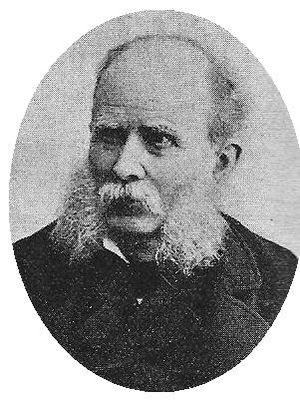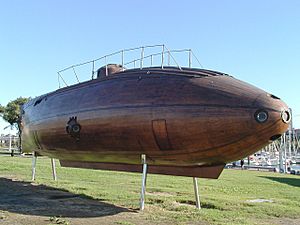Narcís Monturiol facts for kids
Quick facts for kids
Narcís Monturiol
|
|
|---|---|

Narcis Monturiol around 1880
|
|
| Born | 28 September 1819 Figueres, Spain
|
| Died | 6 September 1885 (aged 65) Sant Martí de Provençals (currently Barcelona)
|
| Nationality | Spanish |
| Occupation | Inventor, engineer, artist, politician |
| Known for | Submarine pioneer. Invented the Ictineo I and Ictineo II. |
Narcís Monturiol i Estarriol (born September 28, 1819 – died September 6, 1885) was a Spanish inventor, artist, and engineer. He was born in Figueres, a city in Catalonia, Spain. Monturiol is famous for inventing the first submarine that could run without needing air from the surface and used a special engine.
Contents
The Life of Narcís Monturiol
Monturiol was born in Figueres, Spain. His father was a cooper, someone who makes barrels. Narcís studied law and got his degree in 1845. However, he never worked as a lawyer.
Instead, Monturiol became a writer and publisher. In 1846, he started his own publishing company. He created many journals and pamphlets. In these, he shared his strong beliefs about fairness for women, peace, and a society where everyone shared things equally. He even started a newspaper called "La Madre de Familia" (The Mother of the Family). In it, he promised to "defend women from the tyranny of men." He also founded "La Fraternidad" (The Brotherhood), which was Spain's first communist newspaper.
Monturiol was friends with important people like the musician Josep Anselm Clavé. He also followed the ideas of a thinker named Étienne Cabet. Cabet believed in creating a perfect society where everyone worked together. Monturiol helped share Cabet's ideas through his newspaper.
After some political changes in 1848, the government stopped one of his publications. He had to leave Spain for a short time and went to France. When he came back to Barcelona in 1849, the government limited his publishing work. This made him focus his energy on science and engineering instead.
The Idea for a Submarine
Monturiol visited a town called Cadaqués. There, he saw how dangerous it was for people who harvested coral from the sea. He even saw a man drown while doing this job. This sad event made him think about how to make underwater work safer.
In September 1857, he returned to Barcelona. He started the first company in Spain dedicated to exploring underwater travel. It was called Monturiol, Font, Altadill y Cia. In 1858, Monturiol presented his idea in a scientific paper. He called his invention The Ictineo or fish-ship. The first dive of his first submarine, Ictineo I, happened in September 1859 in the harbor of Barcelona.
The Ictineo I Submarine
The Ictineo I was about 7 meters (23 feet) long. It was designed to help with harvesting coral. The front of the Ictineo had special tools for this job.
During the summer of 1859, Monturiol made more than 20 dives in the Ictineo I. He had his business partner and the shipbuilder as his crew. The Ictineo I was easy to control underwater. However, it was not very fast because it was powered only by human muscles.
Sadly, the Ictineo I was accidentally destroyed in January 1862. This happened after it had completed about fifty dives. A cargo ship crashed into it while it was docked. Today, you can see a modern copy of the Ictineo I at the Marine Museum in Barcelona.
The Ictineo II Submarine
The Ictineo II was meant to be a better version of the first submarine. The Spanish Navy promised to help Monturiol, but they did not give him money. So, Monturiol had to raise money himself. He wrote a "letter to the nation" asking people for help. People from Spain and Cuba donated money, raising 300,000 pesetas. This money was used to start a company called La Navegación Submarina (Underwater Navigation) to build the Ictineo II.
Monturiol wanted to build the Ictineo II entirely out of metal. He also wanted to put the engine in its own separate part of the submarine. But he did not have enough money for a metal submarine. Instead, he managed to get enough funds to put his new engine into the wooden Ictineo II for testing.
On October 22, 1867, the Ictineo II traveled on the surface using steam power for the first time. It went about 3.5 knots (6.5 km/h) and could reach a top speed of 4.5 knots (8.3 km/h). On December 14, Monturiol submerged the submarine. He successfully tested his special engine that did not need air from the surface.
However, on December 23 of that year, Monturiol's company went out of business. They could not get any more money. Monturiol had to give up his only valuable possession, the Ictineo II. The person who took it then sold it to a businessman. The authorities wanted the new owner to pay taxes on the ship. Instead of paying, the businessman took the submarine apart and sold it for scrap metal. Today, you can see a copy of the Ictineo II at the harbor in Barcelona.
Later Life and Legacy
Monturiol's Later Years
In 1868, Monturiol returned to politics. He was a member of the Partido Federal (Federal Party). He became a representative in the government of the First Spanish Republic in 1873. For a few months, he was also the director of the National Stamp Factory in Madrid. There, he found a way to make adhesive paper faster.
Monturiol had many other inventions. These included a system for copying letters, a continuous printer, a fast-firing cannon, and a way to make steam generators work better. He also invented a stone cutter, a method for keeping meat fresh, and a machine for making cigarettes.
Narcís Monturiol died in 1885 in Sant Martí de Provençals, which is now part of Barcelona.
Monturiol's Lasting Impact

Monturiol's idea of a submarine that could run without air from the surface was very advanced. No other submarine used a similar system until 1940. That's when the German Navy tested a system like his. The problem of how submarines could stay underwater for a long time without air was finally solved with the first nuclear-powered submarine, the USS Nautilus.
Spain has honored Monturiol in several ways. In 1987, he was featured on a postage stamp. He also has two monuments. One is in Barcelona, and the other is in Figueres, his hometown. Figueres is also known for another famous person, the artist Salvador Dalí.
The Spanish Navy has also honored him. They named a new submarine after him, the S-82 Narciso Monturiol. This will be the first submarine in the Spanish Navy to use an air-independent propulsion system.
In 2013, a special underwater vehicle was built. It can carry people and go very deep, up to 1,200 meters (3,900 feet). It was named Ictineu 3 to honor Monturiol's original inventions, the Ictineo I and Ictineo II.
See also
 In Spanish: Narciso Monturiol para niños
In Spanish: Narciso Monturiol para niños



